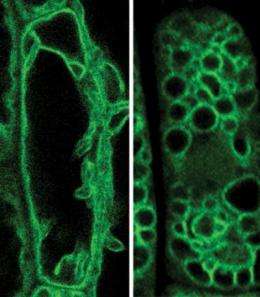Researchers discover how the storehouses of plant cells are formed

Bite into a sour apple and you destroy them - plant cell vacuoles. Even though these vacuoles make up the largest volume of plant cells, only little was known about how these cellular storehouses form and how the substances stored in them find their way there. Scientists at the Technische Universitaet Muenchen (TUM) have now discovered a new protein essential to the formation of vacuoles. In the process they uncovered new clues that may help demystify the vacuole formation mechanism. They now hope to unravel the process completely.
Cells - whether plant, animal or human - comprise a variety of organelles, delineated structures that assume different roles within the cells. In plant cells, the largest organelle by far is the so-called vacuole. Enveloped by a membrane, it stores substances vital for the plant cell -- for example, proteins essential for our nutrition found in peas, beans and lentils, the pigments of blossoms, the bitter substances in tea, or the fruity acids of sour apples. How these vacuoles are formed inside plant cells and how the substances stored in them get there are only vaguely understood. A research team from the TUM Center of Life and Food Sciences Weihenstephan has now discovered a new protein that is indispensable in the formation of vacuoles.
Prof. Claus Schwechheimer and his team of scientists from the Department of Plant Systems Biology used Arabidopsis thaliana as the model plant for their investigations. "Using comparisons of the wild-type variant with a mutant, we were able to demonstrate that a very specific protein substance was all-important in the formation of functional vacuoles," says Schwechheimer. Two things occur when this protein is missing: First, instead of one large vacuole, many small, partially functional ones are produced in the cell. Second, the transport of substances within the plant cells falls into disarray. Instead of finding their way into the vacuoles, the important substances are discharged from the cells - the plant ceases to grow and withers.
The protein the researchers identified functions as a "splitting protein": It can split off a small protein called ubiquitin, found almost everywhere in cells, from other proteins. Appending and removing ubiquitin is a mechanism that cells generally use to initiate and terminate metabolic processes and to assign specific tasks to the proteins involved. The research team used wilted control plants to show that functioning storage organs cannot be produced in cells without the investigated splitting protein. The reason: In absence of the discovered protein, a certain ubiquitin-marked protein substance accumulates - and prevents the cell from forming a normal vacuole. Worldwide, this is the first time ever that researchers have observed that ubiquitin-marked proteins might play a role in the formation of these cellular storage organs.
In a second step, the research team is now searching for the particular ubiquitin-marked protein that blocks the formation of vacuoles. "This will be a tough nut to crack," says Dr. Erika Isono, who is coordinating these studies in the Department of Plant Systems Biology. "For one, it is known that ubiquitin-marked proteins are generally rather unstable and as such difficult to confirm. On the other hand, cells contain myriad ubiquitin-marked proteins with very different tasks." In short: The hunt for this protein, so important in the formation of vacuoles, is not unlike the proverbial search for the needle in a haystack.
The TUM researchers have nonetheless taken up the challenge. Very useful for the pending investigations into this cellular process will be the three new fluorescence microscopes, together worth 500,000 euros, put into operation with financial support from the Deutsche Forschungsgemeinschaft (German Research Foundation), the Technische Universitaet Muenchen, and the state of Bavaria. Once the systems biologists have completely deciphered the vacuole formation process, their work may help to alter the contents of these storage organs in a targeted way in the future. This could lead to improved quality of vegetable food products, for example, by making sour apples sweeter or increasing the protein content of beans, lentils and peas.
More information: Erika Isono, Anthi Katsiarimpa, Isabel Karin Mueller, Franziska Anzenberger, York-Dieter Stierhof, Niko Geldner, Joanne Chory, and Claus Schwechheimer: The deubiquitinating enzyme AMSH3 is required for intracellular trafficking and vacuole biogenesis in Arabidopsis thaliana. Plant Cell (2010) 22(6):1826-1837. Published online on 11 June 2010, DOI:10.1105/tpc.110.075952
Provided by Technische Universitaet Muenchen
















